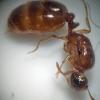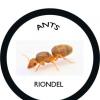How would I move a queen and her broo without harming them and efficiently?
Two ways I can think of. If you have mini outworlds to connect 2 test tubes to. That would be the safest. You just keep the old nesting testtube in the light while making the new test tube dark, they should eventually make the move on their own and bring allbtheir brood with. But that can take days or so. The other way is while holding the two test tubes together you very carefully tap all the ants and brood not sticking to a surface into the new one, this way is really annoying and if your clumbsy like me.. You can hurt or even kill workers or the queen by pinching them between the two test tubes. After that youvwill need a wet cotton swab or a toothpick and every so gently try to manually transfer eggs. Hopefully you already got this figured out before me showing up or hopefully it helps you

















